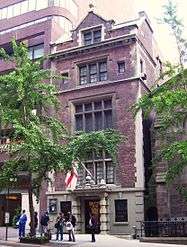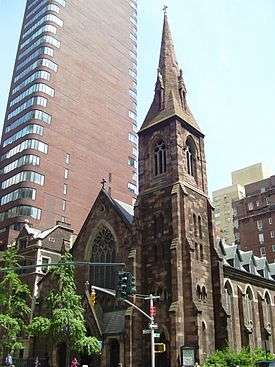Church of the Incarnation, Episcopal (Manhattan)
|
Church of the Incarnation (Episcopal) and Parish House | |
|
(2011) | |
   | |
| Location |
205-209 Madison Ave. Manhattan, New York |
|---|---|
| Coordinates | 40°44′54″N 73°58′57″W / 40.74833°N 73.98250°WCoordinates: 40°44′54″N 73°58′57″W / 40.74833°N 73.98250°W |
| Built | 1864-65 |
| Architect |
church (1865): Emlen T. Littel[1] rectory (1868): Robert Mook[2] re-building (1882): David Jardine[1] spire (1896): Heins and LaFarge (consulting architects)[1] rectory (1905-06): Edward P. Casey[2][3] |
| Architectural style |
church: Late Gothic Revival rectory: neo-Jacobean |
| NRHP Reference # | 82003371[4] |
| Significant dates | |
| Added to NRHP | July 8, 1982 |
| Designated NYCL | September 11, 1979 |
- Not to be confused with the Church of the Incarnation, Roman Catholic (Manhattan) on St. Nicolas Avenue and 175th Street
The Church of the Incarnation is a historic Episcopal church at 205-209 Madison Avenue at the northeast corner of 35th Street in the Murray Hill neighborhood of Manhattan, New York City. The church was founded in 1850[5] as a chapel of Grace Church located at 28th Street and Madison.[5] In 1852, it became an independent parish, and in 1864-85 the parish built its own sanctuary at its current location.
Notable parishioners
Notable among the parishioners of the church were Admiral David Farragut and Eleanor Roosevelt,[6] who was confirmed in the church.[5] The funeral for the mother of Franklin Delano Roosevelt was held at the church, and a ramp was built so that FDR could attend.[5] Several prominent families had pews and have memorials in the church, including the Delanos, Langdons, Sedgwicks, Seaburys, Brooks, and Rikers families.[7]
Buildings

The sanctuary was built in 1864-1865, and was designed by Emlen T. Littel. It was "distinguished for both its architecture and refined interior decoration and artwork."[1] The cornerstone was laid on March 8, 1864 by Bishop Horatio Potter of the New York Diocese, the first services were held on December 11, and the church was consecrated on April 20, 1865. The church rectory was constructed in 1868-69, designed by Robert Mook.[2][3]
Except for its tower and walls, the building was destroyed by a fire which began on March 24, 1882. It was rebuilt and enlarged by David Jardine, with a spire added in 1896 by Heins and LaFarge following Jardine's designs.[1][2] In 1905-06 the church rectory was rebuilt and received a new facade in neo-Jacobean style designed by Edward P. Casey.[3] It is now the H. Percy Silver Parish House.[2]
The building was designated a New York City landmark in 1979, and was added to the National Register of Historic Places in 1982.[8] In 1991, a renovation of the building was supervised by Jan Hird Pokorny.[5]
Artworks
The church contains art work by noted Victorian artists including Louis Comfort Tiffany, John Lafarge, Augustus Saint-Gaudens, Edward Burne-Jones, William Morris, Daniel Chester French and Henry Hobson Richardson.[3]
Stained glass windows
A list of stained glass windows by various artists of the Victorian Era.
South Wall
- "Christ's Resurrection and Ascension" by Henry Holiday Company
- "Moses and the Law" by Heaton, Butler & Bayne
- "St. Paul on Mars Hill" by Clayton & Bell
- "Christ Calling Peter and Paul" by John LaFarge
- "Christian Nurturing" by Henry Holiday Company
- "God as a Good Vintner" by John LaFarge
- "Infant Children" by William Morris of Morris & Company
- "The Pilgrim" by Louis Comfort Tiffany
- "Apostles" by Heaton, Butler & Bayne
North Wall
- "Faith & Charity" by Edward Burne-Jones, Henry Holiday of London
- "Feeding the multitudes" by Cottin & Company
- "Love of Christ", designer unknown
- "Victory over Death" by Tiffany Studios
- "23rd Psalm" by Tiffany Studios
- "Samuel"by Guthrie and Davis
West Wall
- "Dignity of Labor" by Tiffany Studios
- "Great West Window" by Charles Eamer Kempe
See also
- National Register of Historic Places listings in Manhattan from 14th to 59th Streets
- List of New York City Designated Landmarks in Manhattan from 14th to 59th Streets
References
Notes
- 1 2 3 4 5 Reynolds, Donald Martin (1994). The Architecture of New York City: Histories and Views of Important Structures, Sites, and Symbols (rev. ed.). New York: John Wiley & Sons. p. 118. ISBN 0-471-01439-7.
- 1 2 3 4 5 White, Norval & Willensky, Elliot (2000), AIA Guide to New York City (4th ed.), New York: Three Rivers Press, ISBN 978-0-8129-3107-5, p.241
- 1 2 3 4 New York City Landmarks Preservation Commission; Dolkart, Andrew S. (text); Postal, Matthew A. (text) (2009), Postal, Matthew A., ed., Guide to New York City Landmarks (4th ed.), New York: John Wiley & Sons, ISBN 978-0-470-28963-1, pp.97-98
- ↑ National Park Service (2009-03-13). "National Register Information System". National Register of Historic Places. National Park Service.
- 1 2 3 4 5 Dunlap, David W. (2004). From Abyssinian to Zion: A Guide to Manhattan's Houses of Worship. New York: Columbia University Press. ISBN 0-231-12543-7., p. 111
- ↑ Church of the Incarnation, About (Retrieved 9 May 2011)
- ↑ J. Douglas Ousley, "A Guide to the Interior of the Church of the Incarnation", (n.d., c. 2010).
- ↑ Church of the Incarnation, Landmark Building (Retrieved 9 May 2011)
External links
- Official website
 Media related to Church of the Incarnation, Episcopal (Manhattan) at Wikimedia Commons
Media related to Church of the Incarnation, Episcopal (Manhattan) at Wikimedia Commons
